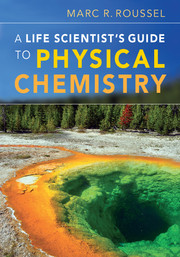Book contents
- Frontmatter
- Contents
- Preface
- 1 Orientation: what is physical chemistry about?
- Part One Quantum mechanics and spectroscopy
- Part Two Thermodynamics
- Part Three Kinetics
- 11 Basics of chemical kinetics
- 12 Initial rate experiments and simple empirical rate laws
- 13 Integrated rate laws
- 14 Complex reactions
- 15 Enzyme kinetics
- 16 Techniques for studying fast reactions
- 17 Factors that affect the rate constant
- 18 Diffusion and reactions in solution
- Appendix A Standard thermodynamic properties at 298.15 K and 1 bar
- Appendix B Standard reduction potentials at 298.15 K and 1 bar
- Appendix C Physical properties of water
- Appendix D The SI system of units
- Appendix E Universal constants and conversion factors
- Appendix F Periodic table of the elements, with molar masses
- Appendix G Selected isotopic masses and abundances
- Appendix H Properties of exponentials and logarithmic functions
- Appendix I Review of integral calculus
- Appendix J End-of-term review problems
- Appendix K Answers to exercises
- Index
16 - Techniques for studying fast reactions
from Part Three - Kinetics
Published online by Cambridge University Press: 05 June 2012
- Frontmatter
- Contents
- Preface
- 1 Orientation: what is physical chemistry about?
- Part One Quantum mechanics and spectroscopy
- Part Two Thermodynamics
- Part Three Kinetics
- 11 Basics of chemical kinetics
- 12 Initial rate experiments and simple empirical rate laws
- 13 Integrated rate laws
- 14 Complex reactions
- 15 Enzyme kinetics
- 16 Techniques for studying fast reactions
- 17 Factors that affect the rate constant
- 18 Diffusion and reactions in solution
- Appendix A Standard thermodynamic properties at 298.15 K and 1 bar
- Appendix B Standard reduction potentials at 298.15 K and 1 bar
- Appendix C Physical properties of water
- Appendix D The SI system of units
- Appendix E Universal constants and conversion factors
- Appendix F Periodic table of the elements, with molar masses
- Appendix G Selected isotopic masses and abundances
- Appendix H Properties of exponentials and logarithmic functions
- Appendix I Review of integral calculus
- Appendix J End-of-term review problems
- Appendix K Answers to exercises
- Index
Summary
Many elementary chemical reactions occur on extremely short time scales (down to femtoseconds). Special experimental and mathematical methods are required to study fast processes. Here, we will focus on reactions in solution. Some of the methods described here are also adaptable to gas-phase reactions, but there are also some gas-phase methods that are quite different from anything we would use in solution. Also note that this chapter does not provide a comprehensive survey of methods, even for reactions in solution. The intention is to discuss a few particularly important methods, which hopefully will give you a flavor of the various approaches available.
Flow methods
The continuous flow method
The basic idea behind the continuous flow method is very simple: the reactants are supplied at a constant rate into a tube where the reaction takes place. At constant flow velocity, positions in the tube correspond to specific times since mixing, the relationship between time and the distance from the mixing chamber L being t = L/v. By varying the flow speed or moving a detector along the length of the tube, we can therefore study the course of a fast reaction at our leisure.
- Type
- Chapter
- Information
- A Life Scientist's Guide to Physical Chemistry , pp. 314 - 329Publisher: Cambridge University PressPrint publication year: 2012



